
The Amber Road was an ancient trade route for the transfer of amber from coastal areas of the North Sea and the Baltic Sea to the Mediterranean Sea. Prehistoric trade routes between Northern and Southern Europe were defined by the amber trade.

Albania is a small country in Southern, Southeastern Europe and Western Balkans strategically positioned on the Adriatic and Ionian Sea inside the Mediterranean Sea, with a coastline of about 476 km (296 mi). It is bounded by Montenegro to the northwest, Kosovo to the northeast, North Macedonia to the east and Greece to the southeast and south.

Fucus vesiculosus, known by the common names bladder wrack, black tang, rockweed, sea grapes, bladder fucus, sea oak, cut weed, dyers fucus, red fucus and rock wrack, is a seaweed found on the coasts of the North Sea, the western Baltic Sea and the Atlantic and Pacific Oceans. It was the original source of iodine, discovered in 1811, and was used extensively to treat goitre, a swelling of the thyroid gland related to iodine deficiency.
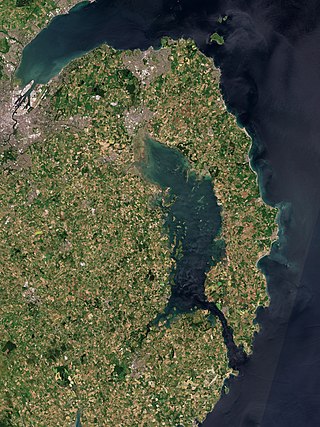
Strangford Lough is a large sea lough or inlet in County Down, in the east of Northern Ireland. It is the largest inlet in Ireland and the wider British Isles, covering 150 km2 (58 sq mi). The lough is almost fully enclosed by the Ards Peninsula and is linked to the Irish Sea by a long narrow channel at its southeastern edge. The main body of the lough has at least seventy islands along with many islets (pladdies), bays, coves, headlands and mudflats. Historically it was called 'Lough Coan', while 'Strangford' referred to the narrow sea channel. It is part of the 'Strangford and Lecale' Area of Outstanding Natural Beauty. Strangford Lough was designated as Northern Ireland's first Marine Conservation Zone in 2013, and has been designated a Special Area of Conservation for its important wildlife.

Fucus is a genus of brown algae found in the intertidal zones of rocky seashores almost throughout the world.
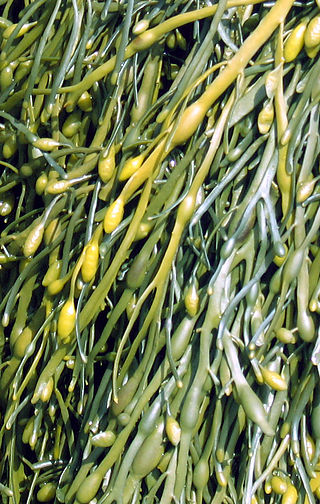
Ascophyllum nodosum is a large, common cold water seaweed or brown alga (Phaeophyceae) in the family Fucaceae, being the only species in the genus Ascophyllum. It is a seaweed that grows only in the northern Atlantic Ocean, also known in localities as feamainn bhuí, rockweed, Norwegian kelp, knotted kelp, knotted wrack or egg wrack. It is common on the north-western coast of Europe including east Greenland and the north-eastern coast of North America, its range further south of these latitudes being limited by warmer ocean waters.
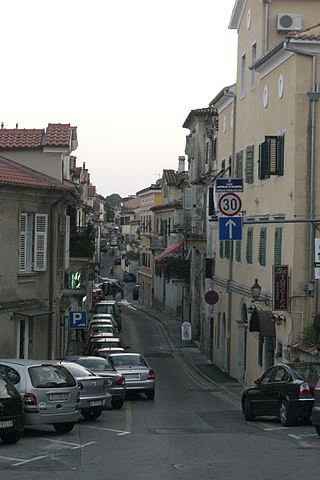
Volosko is a part of the city of Opatija, located in the Kvarner Gulf in western Croatia. It is located in the north of Opatija, on the road towards Kastav and Rijeka. The toponym Volosko drives from the name of the Slavic deity Veles.

Trans Adriatic Pipeline (TAP) is a natural gas pipeline proposed in 2003, constructed in 2016, and operational since 2020, from Azerbaijan at the Caspian Sea to Europe from Greece through Albania and the Adriatic Sea to Italy. It is a European section of the Southern Gas Corridor. As of 2022 capacity is 10 bcm per year.

USS League Island (AG-149/AKS-30) – also known as USS LST-1097 - was an LST-511-class tank landing ship launched by the U.S. Navy during the final months of World War II. League Island served as a supply and stores-issue ship for the U.S. 7th Fleet, and was decommissioned after the war.
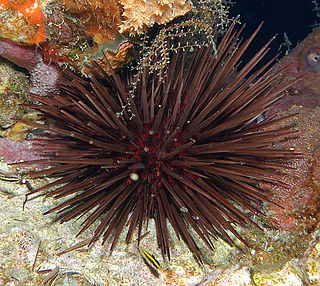
The Atlantic purple sea urchin is a species of sea urchins from the family Arbaciidae, native to the Atlantic Ocean.

The Adriatic Sea is a body of water separating the Italian Peninsula from the Balkan Peninsula. The Adriatic is the northernmost arm of the Mediterranean Sea, extending from the Strait of Otranto to the northwest and the Po Valley. The countries with coasts on the Adriatic are Albania, Bosnia and Herzegovina, Croatia, Italy, Montenegro, and Slovenia.

SS Myron was a wooden steamship built in 1888. She spent her 31-year career as lumber hooker, towing schooner barges on the Great Lakes. She sank in 1919, in a Lake Superior November gale. All of her 17 crew members were killed but her captain survived. He was found drifting on wreckage near Ile Parisienne. Her tow, the Miztec, survived. Myron defied the adage that Lake Superior "seldom gives up her dead" when all 17 crewmembers were found frozen to death wearing their life jackets. Local residents chopped eight of Myron's sailors from the ice on the shore of Whitefish Bay and buried them at the Mission Hill Cemetery in Bay Mills Township, Michigan.

The Bay of Vlorë is a large bay of the Adriatic Sea situated along the Albanian Adriatic Sea Coast on the Mediterranean Sea in Southern Europe. It opens to the sea in the northwest and is largely surrounded by the lagoon of Narta in the north, the city of Vlorë in the northeast, the mountains of the Ceraunians in the east and southeast, and the peninsula of Karaburun in the southwest and west.

The Dévastation-class ironclad floating batteries were built for the attack of Russian coastal fortifications during the Crimean War. France had intended to build ten of these vessels, but in the time available was only able to construct five in French shipyards, of which the first three took part in the attack on Kinburn in 1855, and served in the Adriatic in June–July 1859 during the Italian war.

Fucus radicans is a species of brown algae in the family Fucaceae, endemic to and recently evolved within the Baltic Sea. The species was first described by Lena Bergström and Lena Kautsky in 2005 from a location in Ångermanland, Sweden. The specific epithet is from the Latin and means "rooting", referring to the fact that this species primarily reproduces by the taking root of detached fragments.

VP-93, nicknamed the Executioners, was a Patrol Squadron of the U.S. Navy Reserve. It was the second squadron to be assigned the VP-93 designation. The squadron was established on 1 July 1976 and disestablished 18 years later, on 30 September 1994. It flew the Lockheed P-3 Orion, and was based at NAF Detroit during its entire life. Units of the squadron made 17 major overseas deployments.
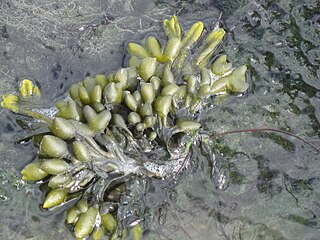
Fucus ceranoides is a species of brown algae found in the littoral zone of the sea shore.

Patok Lagoon is a lagoon of the Adriatic Sea on the Mediterranean Sea in the central coast of Albania.

The Albanian Adriatic Sea Coast stretches in the Southeastern Adriatic Sea beginning at the Gulf of Drin in the north, across the port cities of Shëngjin, Durrës and Vlorë, to the Bay of Vlorë in the south, where the Albanian Riviera as well as the Albanian Ionian Sea Coast begins.


















